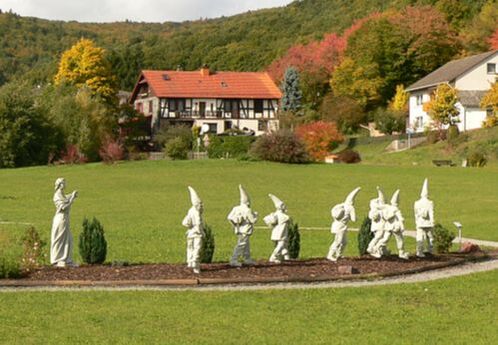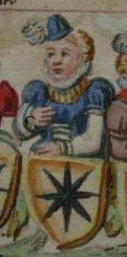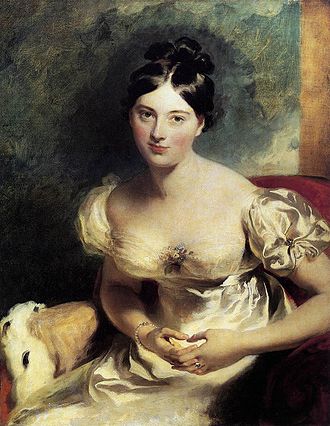|
Last month, I discussed 18th-century philanthropist Maria Sophia von Erthal, theorized to be the "real" Snow White. Not long after this theory was published, a similar argument was made for a completely different candidate. The theorist this time was Eckhard Sander, a mathematics and German teacher from Borken. The Maria Sophia theory had a playful feel; even its creator didn't take it too seriously. This next theory is its darker, edgier sister. Sander's candidate for Snow White was Margarethe von Waldeck. This stunningly beautiful young woman lived near a mining town which used children as laborers. After her father remarried, she was sent away from home. Ultimately, she was poisoned for her beauty and died young - assassinated because a prince fell in love with her. This theory seems pretty simple on its face, but it’s actually much more elaborate. Sander’s theory is not exactly that Margarethe von Waldeck was the real Snow White. Instead he proposes that the tale of Snow White originated in Waldeck in the late 16th century, with the plot points drawn from local legends and the main character a composite of three different people all named Margarethe. Margarethe von Waldeck (1533-1554): The Beauty Location: Bad Wildungen, Hesse Margarethe was the daughter of Philip IV, Count of Waldeck and his wife Margarethe von Ostfriesland. They lived in the town of Bad Wildungen, in the mountain range known as the Kellerwald. Young Margarethe was exceptionally beautiful, with blonde hair. This might sound like it rules her out - Snow White is supposed to have ebony-black hair, after all - but it's a little-known fact that Snow White was blonde in the Grimms' 1810 draft. Margarethe was the seventh or eighth child in the family. In 1537, when she was four, her mother died in childbirth. In 1539, Philipp took a second wife, the widowed Catharina von Hatzfeld. Sander hints coyly that perhaps Catharina was jealous of her lovely stepdaughter, but he presents little evidence for this. However, Margarethe was apparently sent to live elsewhere at a young age. Catharina died in 1546. At some point, Margarethe was sent to the royal court of Brussels in Belgium. ("Richilde," a 1782 version of Snow White, also takes place in Belgium.) She attracted the romantic attentions of Prince Philip, later to be King Philip II of Spain, but then she fell ill and died in the year 1554. She was just 21. According to rumor, she had been poisoned. Was this the work of political rivals who didn't approve of the relationship? Later that year, Count Philipp IV married his third wife, Jutta of Isenburg-Grenzau. Margarethe's brother Samuel also got married that year. From their father he inherited land including a mining settlement, which would eventually become the town of Bergfreiheit. He put up boundary markers called Bloodstones (Blutsteine). Sander compares this to an obscure Snow White variant from the Grimms' notes: driving through the woods, a count and countess see three piles of snow, three pits of blood, and three black ravens, prompting the count to wish for a girl of those colors. Samuel built up the local copper mines and granted miners additional freedoms. However, there was a dark side to the industry. Children were used as miners because they could squeeze into the small tunnels. They lived in terrible conditions, many of them stunted in growth and prematurely aged due to their work, so that people referred to them as dwarfs. Large numbers were crammed into small houses with only a couple of rooms - hence, says Sander, the idea of the seven dwarfs living in a tiny cottage. Margarethe von Waldeck (1564-1575): The Child Margarethe was the youngest child of Samuel and his wife, Anna Maria von Schwarzburg. She shared a name with her paternal grandmother and aunt. She had six older brothers, all of whom died in infancy except for one, Günther. Samuel died in 1570, when little Margarethe was six. Anna Maria had been carrying on an affair with Samuel's secretary, Göbert Raben, and they secretly married after his death. The scandal infuriated her relatives, who tried to nullify the marriage. A family genealogy suggests that Anna Maria's licentious behavior continued even after she married the secretary (although I suspect some bias here). Margarethe was sent to live with relatives. In 1575, at the age of just eleven, she fell from a cliff while picking flowers and died. Sander compares this to a variant mentioned in the Grimms' notes - here, rather than sending Snow White with the huntsman, the queen takes Snow White into the forest herself in her carriage. She tells her to pick some roses, and then drives off, abandoning her. Sander also takes note of Margarethe's young age; one early manuscript of Snow White described the heroine as an "unfortunate child." In 1576, a year after her daughter's death, Anna Maria and her lover were imprisoned. Her lover was released after two years and sent into exile, but Anna Maria spent the rest of her life shut up in a convent. A dead child. A perverse mother figure imprisoned for her crimes. Out of this history, Sander picked another Snow White story. Margarethe von Waldeck (1559-1580): The Bride Margarethe was the daughter of Johann I von Waldeck, from another branch of the same family. In 1578, at age nineteen, she traveled to marry Count Günther von Waldeck (her distant cousin, Samuel's son, Margarethe I's nephew, Margarethe II's brother). It was an elaborate wedding with an elite guest list, processions, feasting, and a four-day-long afterparty. Sander tied this to the wedding and happily-ever-after of Snow White and her prince. But even this Margarethe didn't get a happily-ever-after; she died childless two years after the wedding. A couple years after that, Gunther took a second wife, also named Margarethe. Folktales of Bad Wildungen Sander bulked up his theory with various legends and historical facts from around the area.
Inaccuracies and problems As with the Maria Sophia theory, there are a few inaccuracies that pop up now and again in articles on the subject. Again, these generally have to do with lines between the history and the fairytale being blurred. Claim: Catharina had something to do with her stepdaughter Margarethe's poisoning. Most people correctly spot that this is impossible, since Catharina died long before her stepdaughter. In fact, in his original book, Sander actually focused on Margarethe II's mother, Anna Maria, as the inspiration for the "evil queen" character. Claim: This is a portrait of Margarethe von Waldeck. This is Irish writer Marguerite Gardiner, Countess of Blessington (1789-1849). This is a mistake spread through various online articles and I'm not sure where it started, but I'd guess someone thought this woman looked Snow White-like and got confused by the fact that she was a countess named Margaret.
Claim: Margarethe's shaky handwriting on her deathbed will is a clue that she was poisoned. This one is honestly confusing; a dying woman having shaky handwriting is not weird. I think this may be misleading wording, with the idea stemming from a 2005 German documentary titled Snow White and the Murder in Brussels. It was 45 minutes long and put forward the theory that Margarethe had been poisoned with arsenic. Dr. Gerhard Menk, a historian interviewed in the documentary, stated: "When she wrote the will, it was absolutely clear to her that her life would not last very long. The will shows clearly blurred handwriting. She wrote with a hand that was shaky. And in this respect death is foreseeable relatively early." As for the viability of the Margarethe theory . . . Sander pulls from everything he can find in history and in the Grimms' manuscripts. Blonde hair and a stepmother from Margarethe I (even though in the Blonde Snow White draft, her biological mother is the villain). Two more Margarethes to provide any missing Snow White-esque details. Poison apples from a local legend - never mind that they bear no resemblance to the poison apple in Snow White. And I feel like Sander makes too much of the young Margarethes being sent to live elsewhere. He implies that family drama was the cause, particularly that the mother or stepmother was to blame. Maybe this was the case for Margarethe II. But historical nobility often sent their newborns off to wet nurses, which could mean being away from them for long periods of time. Some royal parents were very involved with their children's lives, but even they might send their children to be raised and educated elsewhere. Princes like Edward VI of England had their own households when they were still young children. In particular, Margarethe I going to Brussels would have been a natural step for a teenaged noblewoman, a huge opportunity for her education and marital prospects and a strategic political move for her family. Where did this theory come from? Sometime before 1990, Eckhard Sander was writing a term paper for a course at the Justus Liebig University. He was interested in writing about the history of child labor in mining, so he and his family toured a Bergfreiheit copper mine. Their guide claimed that the sight of the children in their protective felt caps emerging from the mountain had inspired the dwarfs of "Snow White." Intrigued, Sander sought more evidence with help from his professor Gerd Rötzer. Sander was aware of the Hansel and Gretel hoax from the '60s, but unlike the Lohr "study group," he preferred to distance himself from it. He dove deep into the history of the Grimms' work and the various drafts of Snow White, and concluded that fairytales contain a kernel of truth, unconscious memories of real events. The Grimms would have collected the story of Snow White while unaware of the events that had shaped it only a couple of centuries before. Tiny, easily-missed details in the various versions still pointed to the real history. In 1990, Sander submitted his term paper under the title "Snow White: Fairytales or Truth? An attempt to localize KHM 53 in the Kellerwald." He published it as a book in 1994, with a slightly different subtitle, A local reference to the Kellerwald. This enjoyed similar success as the Maria Sophia theory. Bergfreiheit now hosts the tourist destination of Schneewittchendorf (Snow White Village). Sander was involved in the making of Snow White and the Murder in Brussels. In 2013, he wrote another book in collaboration with the city of Bad Wildungen, The Life of Margaretha von Waldeck, which is available directly from Bergfreiheit gift shops. Based on Sander's story of the mine tour, at least some locals were already claiming Snow White as their own, which would have added to the momentum. But Margarethes II and III - the Child and the Bride - seem nearly forgotten, even though they provided key plot points for Sanders’ elaborate patchwork version of Snow White. Margarethe I is the famous one, who had her death dramatized in the Murder in Brussels documentary. This is probably because spreading Snow White to multiple historical figures weakens the appeal of the theory. It's basically admitting that you don't have a good argument. Margarethe I is the one best able to carry the theory on her own, so she gets the limelight. Conclusion There are many parallels between the Margarethe and Maria Sophia theories. Both theories were conceived and published within a few years of each other. Both rely on the idea that the Grimms visited or lived near the area. Both focus less on the plot of the story, and more on details like the forks, the mountains, the glassware, or the ironworking. And both became popular because the local towns saw them as perfect tourism opportunities. Karlheinz Bartels and Eckhard Sander both went digging through history for women who matched Snow White's description. In doing so, they were proponents of euhemerism, the theory that legends are based on real people. But what if we don't set out looking for a specific historical personage? What if we look at the history of the actual folktale? Next up: Snow White. OTHER BLOG POSTS
SOURCES
2 Comments
|
About
Researching folktales and fairies, with a focus on common tale types. Archives
July 2024
Categories
All
|
Writing in Margins



 RSS Feed
RSS Feed
